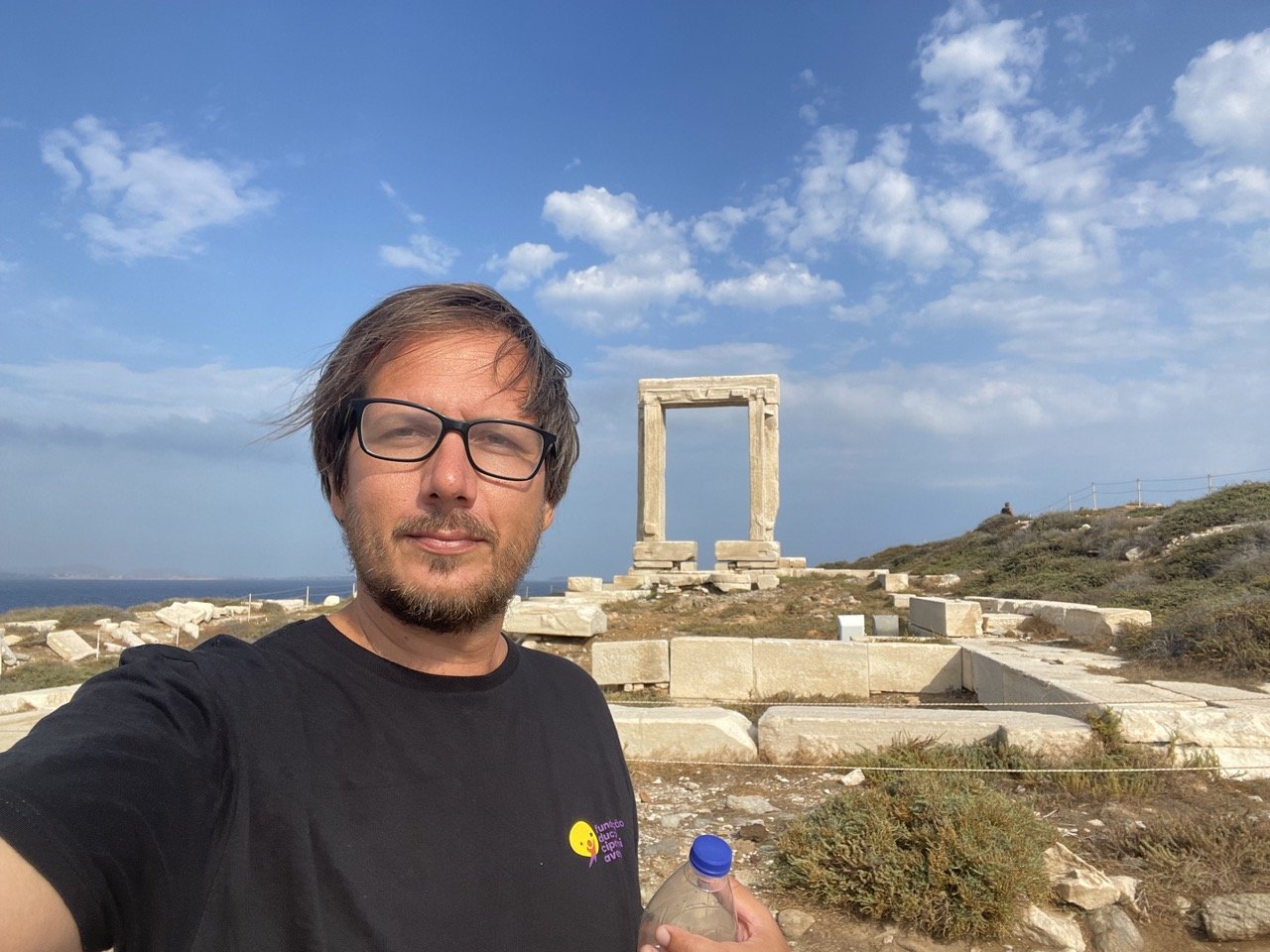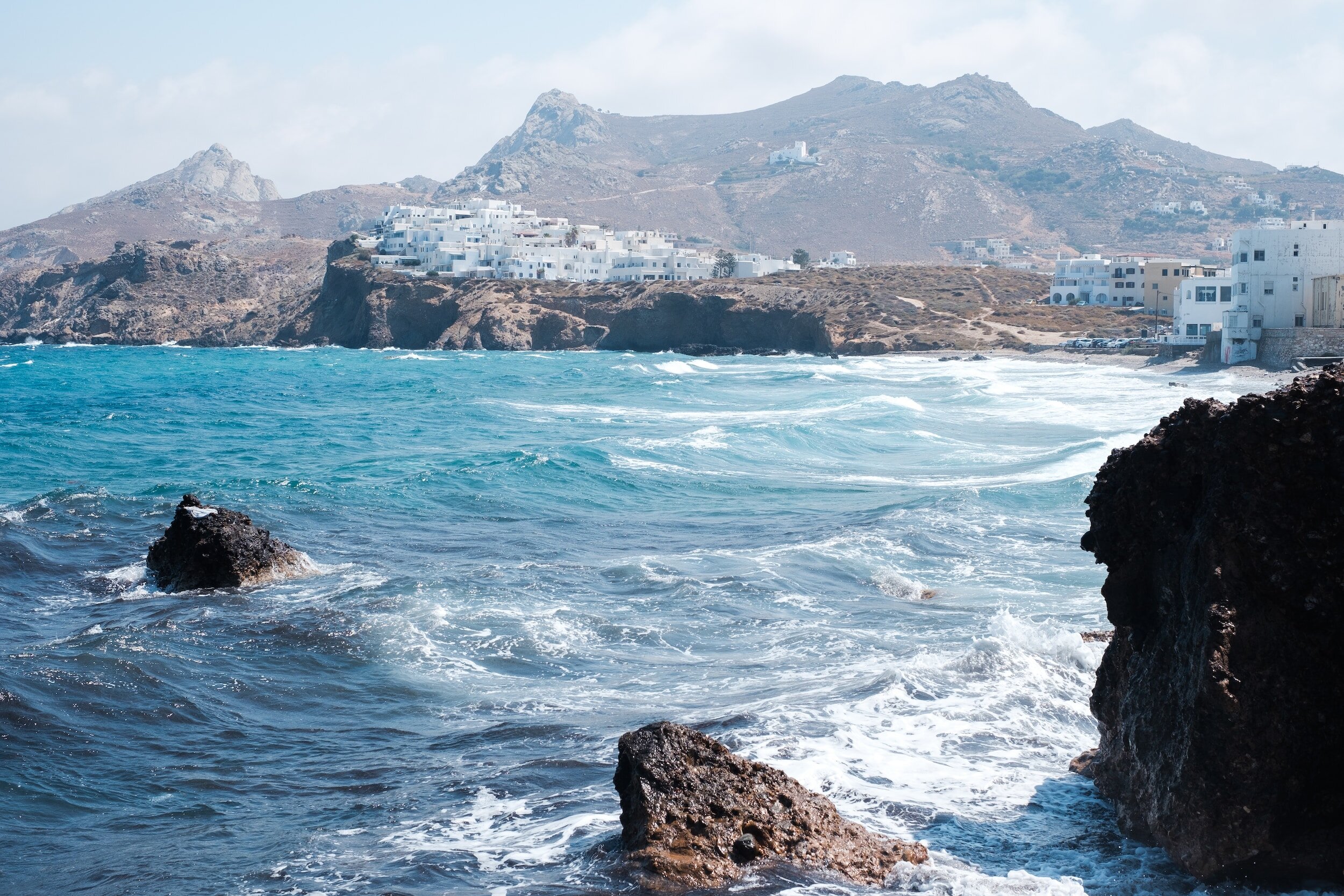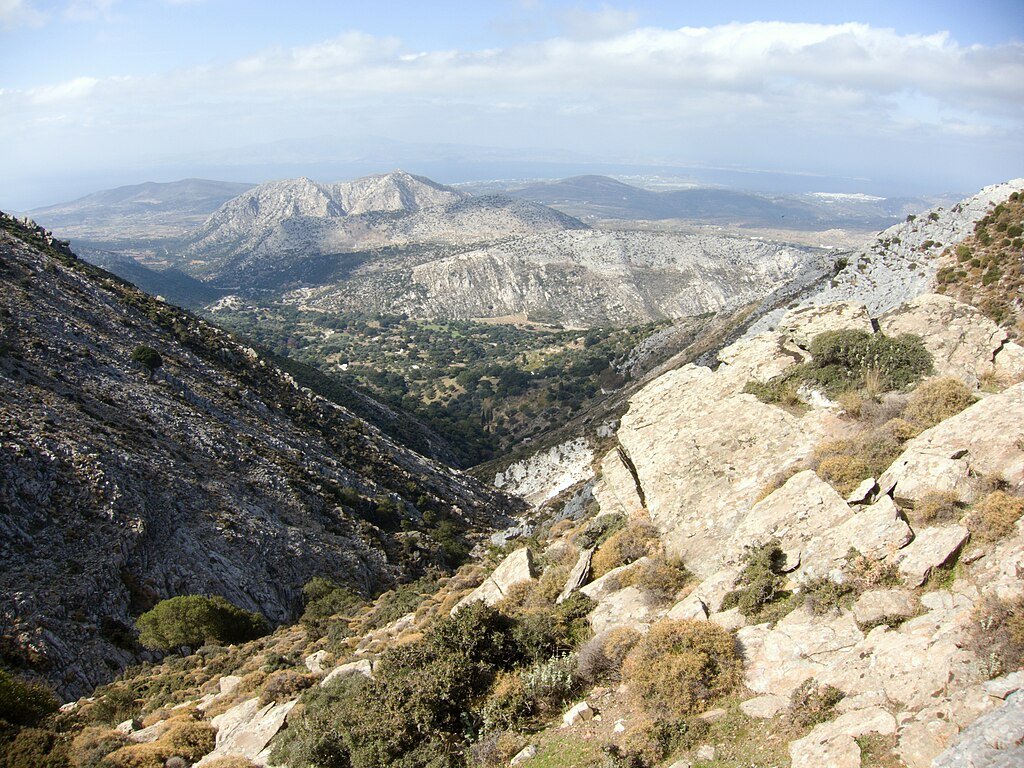A Local’s Guide to Visiting Naxos, Greece
Affiliate disclosure: some of the links in this article are affiliate links. If you book using one of them, we’ll earn a small commission. All of our info is free to read and free of ads, so we appreciate it!
Set almost in the very geographic center of the Aegean Sea, Naxos is a welcoming and easily accessible island, the fruitful and prosperous garden of the Cyclades and their people.
This island has everything that is Greece is renowned for: a rich and historic tapestry that spans millennia, delicious culinary traditions, unique villages, and some of the most beautiful beaches in the Cyclades.
Apart from its main sights, Naxos is a tranquil island ideal for anyone seeking a peaceful retreat to spend quiet days with family and friends. And if you seek to combine a bit of history and culture with your relaxing islands vacation, even better.
Naxos has a historically rich hinterland adorned with ancient ruins (some of whose origins are still mysteries), natural wonders, and quaint villages that demonstrate centuries-old traditions.
Whether you’re an experienced traveler or are venturing to the Greek islands for the first time, Naxos is an ideal starting point. This island warmly welcomes all visitors, and introduces you perfectly to the essence of island life.
Table of Contents
Local help with your planning
If you could use some help figuring out your plan for visiting the Greek islands, schedule a Greece travel consultation with Luca, our Sifnos-based Local Expert!
These are one-hour Zoom calls where you’ll get to chat with Luca about the trip you’re planning and he’ll share his tips and advice, answer your travel questions, and help you perfect your itinerary.
Where is Naxos
Photo: User: Bgabel at wikivoyage shared, CC BY-SA 3.0, via Wikimedia Commons
Naxos is situated in the very center of the Aegean Sea, about 103 nautical miles southeast of Athens. Within the Cyclades, it’s one of the more southern islands of the complex, and is surrounded by Paros, Ios, and Amorgos.
One of the largest islands in the Cyclades complex, Naxos covers 170 square miles and has a year-round population of close to 20,000 residents.
How to get to Naxos
Naxos has an airport and ferry port, so how you choose to get here will depend on your preferred choice of transportation, or whether you’re coming from Athens or another Cycladic island. Here’s a bit of information on all of your options:
By plane
Naxos has its own airport which is connected with Athens via regular daily flights. The two main airlines aire Olympic Airlines (a domestic company of Aegean Airlines) and SkyExpress. Together, they provide frequent connections from April to October, ranging from about 4 daily flights at the beginning of the season to 10 or more in the summer high season.
Even in winter, there is still at least one daily connection.
One-way ticket prices usually range from about €50 to €140, with prices being highest in the summer and always more expensive if booked last-minute, in any season. Keep in mind that strong winds, especially in winter and on summer days when the Meltemi winds blow through, can affect flights.
By ferry from Athens
Naxos can also be reached by ferry from all three ports in Athens: Piraeus, Rafina, and Lavrio. From Piraeus, there is at least one daily ferry all year round, increasing to multiple daily connections from April through October, peaking at about 6 to 7 ferries per day in July and August.
From Rafina, which is closer than Piraeus to Athens Airport, there are usually between 2 and 3 connections per day from June to September. If you plan to arrive into Athens by plane and then catch an immediate ferry to Naxos, booking a boat departing from Rafina is certainly the most convenient option.
Once per week, even in winter, a ferry departs from the port of Lavrio.
From all ports, one-way ferry tickets in the “economy” category range from 40 to 80 euros depending on schedules, speed of the journey, and ferry type.
By ferry from other islands
If you’re planning to arrive into Naxos from another island which you’ll be visiting first, the most frequent connections are between Mykonos and Santorini. From April to October, there is usually at least one ferry a day between Naxos and both islands.
Prices for a one-way “economy” ticket are around 60 euros. The journey takes between 40 minutes and 1.5 hours if coming from Mykonos, and 1.5-2 hours from Santorini.
From Paros: there are direct daily connections in high season. The crossing takes less than 1 hour and costs between 20 and 35 euros.
From Crete: from April to October, there is at least one daily connection between Naxos and the port of Heraklion on Crete. The price for a one-way ticket is about 100 euors and the journey time is approximately 3.5 hours.
In winter, there are no direct connections, so you would instead need to make a stopover first in the port of Piraeus.
Where to buy ferry tickets
The main ferry companies to Naxos are Blue Star Ferries, Seajets, FastFerries, and Hellenic Seaways.
To check schedules and prices, I recommend using Ferry Scanner. It’s an aggregator that shows options from a bunch of different ferry companies. Their schedules are always up to date, it’s easy to use, and the price difference between using them and booking direct is negligible.


Why visit Naxos
Naxos offers an array of incredible activities suitable for all visitors. Those seeking a laid-back beach vacation will enjoy miles of sandy beaches and dunes, some with amenities and beach bars, others natural and uncrowded. And for enthusiasts of beach sports like windsurfing and kite-surfing, Naxos provides ideal conditions.
Venturing into the island's interior, especially in the valley at the foot of the imposing 3,000 foot-high Mount Zas, Naxos unveils ancient paths amidst olive trees. Here, explorers can stroll among ancient Byzantine churches, some dating back thousands of years, or stumble upon impressive marble statues like the Kouroi of Flerio and Apollonas, left abandoned and unfinished since probably the 7th Century B.C.
In this hinterland, visitors can discover the most authentic aspects of Naxos and you can join truly excellent food and wine tours to savor the local delicacies that the island is known for (some of which are also conveniently available in stores in Chora – Naxos’ main town)
The historic center of Naxos’ Chora is a Cycladic maze that will transport you back in time to explore this island’s millennia-long history. From the incredible statuettes of the prehistoric Cycladic Civilization, dating back to about 3000 BC and housed in the Archaeological Museum, to strolling through small alleys adorned with churches, monasteries, and palaces, and finally reaching the harbor and the iconic Portara - an “interrupted” temple dedicated to Apollo dating back to the 6th century BC.
When to visit Naxos
Photo: Muriel Pécastaing-Boissière, CC BY 3.0, via Wikimedia Commons
The absolute best time to explore Naxos is during the month of June, which strikes an excellent balance between near-perfect weather and manageable crowds. High season doesn’t really begin until July, so June offers still-affordable prices and the weather is perfect for whatever type of activities you want to do on the island.
The warm but not too-hot days are great for refreshing swims in the Aegean Sea, and for those interested in hiking, even midday excursions under an open sun will be bearable (more so at the start of the month though).
June is generally characterized by milder winds, making it conducive to day cruises to secluded beaches and neighboring islands.
If you can’t make it in June, September is a good alternative. The days are a bit shorter compared to in June, but the weather is still excellent (not too hot, nor chilly yet) and the summer high season will be winding down by then and the atmosphere is much more laid-back.
Locals begin to unwind in September, and the islands slips back into the rhythms of daily life.
Visiting in spring
Spring in the Cyclades unveils unique colors and blooms, offering a stark contrast to the scorching summer heat which turns everything brown. With warm weather and long days, it's the perfect time for trekking and outdoor activities, and by the end of the season, it will be warm enough for swimming.
Additionally, Easter falls in spring, and this cherished holiday throughout Greece takes precedence over all else. An Easter visit offers a rare moment of serene authenticity. While a few clubs may be open, the experiences you gain on a visit to Naxos during this festive time are truly special and authentically Greek.
Visiting in summer
Summer is the most popular time to visit Naxos and the Cyclades islands more generally, and the island is certainly much, much more crowded during summer than at other times. Visitors from all over the world descend on Naxos during this period, and the beaches are bustling with people, while demand for just about everything skyrockets, with prices increasing accordingly.
The atmosphere is festive and electric, and the island is bursting with life and excitement.
The weather during the summer is what you would expect: temperatures are high and the middle of the day can be scorching hot. Summer is also characterized by strong Meltemi winds, which can affect everything from lights to boat trips and watersports.
While some smaller islands might feel overwhelming and overcrowded during the summer, Naxos is big and it has multiple towns for visitors to stay in, along with many beaches to visit, so fortunately, it is still very nice to visit, even during the height of high season.
Visiting in fall
Fall, with its pleasant temperatures, diminished crowds, and pleasant pace of life is a great time to visit Naxos, especially if you want to enjoy active days exploring the island on foot. During the fall, you can experience firsthand the island´s great rural tradition and witness the importance of the grape harvest, and later in the season, the olive harvest.
Fall is also a period when it is easier to interact with locals, as they will be unburdened by the crowds and hectic pace of the summer. In the later part of the season, beginning in the middle of October, tourism-oriented establishments will slowly begin to close for the winter break, but plenty of hotels and other service providers will still be open.
The weather in autumn can mostly gives the feeling of late summer days, but it’s not infrequent to have short periods of strong winds and rain that often lower temperatures a fair deal.
Visiting in winter
There are not many Cycladic islands that can be easily visited in winter, but Naxos is one of the few that can be! Being an island with a sizable year-round population and many activities totally independent of tourism, Naxos has a fair offering of hotels open all throughout the year.
The Chora, much quieter than at other times of year, turns into a pleasant little town with relaxed but constant activity. With almost no other tourists around, you’ll be surrounded by routine, daily life, and even if just for a moment, it’s easy to feel like you belong here - just another local.

How long to spend in Naxos
To fall in love with Naxos probably takes only a few moments, but to be able to say that you have appreciated its cozy yet rural nature, 3-4 days is really the minimum amount of time needed. Of course, if Naxos is just one stop on a long island-hopping tour, it’s not uncommon to stay here for just a couple of nights, which is still enough to get a taste for the island, if not to really get to know it.
As I’ve mentioned above, Naxos is a big island with a wide array of attractions, and you could easily spend your entire vacation here. The ideal stay to experience everything would be a week, or even better two, which would allow you to explore at a leisurely pace (you’re on the islands after all!), visiting many beaches, touring much of the interior, and setting off on boat trips to the surrounding area.
Assuming that you plan to visit Naxos as part of a trip to at least a few other islands and only have 3 or 4 days to spare, here’s how I’d suggest spending your time:
You can dedicate a day to Naxos Town, starting perhaps with an early morning stroll to the Portara (sunset is more popular, but also very crowded), before venturing through the alleys of the old town and visiting the archaeological museum (due to reopen in 2024!), the Catholic church at the top of the Kastro, and the former Ursuline school.
Spend another day exploring the beauties of the hinterland, such as Kouros of Flerios, the temple of Demeter, the Frantoio Museum of Eggares, and the inland villages such as Apeiranthos, Filoti and Chalki.
On your third day, forget about activities and enjoy the spectacular beaches, from Plaka to Kastraki. This should be a day of pure, blissful leisure.
To end your time in Naxos, why not take a boat cruise out to the nearby islands and coves unreachable by land? Or, depending on your interests, spend another day exploring more archaeological sites, visiting other villages, louning on the beaches, or touring the vineyards and olive groves and sampling the local specialties
Where to stay in Naxos
The choice of the ideal place to stay depends on the type of vacation you have in mind.
If you prioritize immersing yourself in the life of Naxos and exploring as much as possible, Naxos Town is the ideal base. It's a lively area with all the offerings of a small but busy town, is well-served by amenities, and is close to public transportation and strategically located near the port.
For simple but still very nice budget options, B&Bs and small, family-run hotels in nearby New Chora are your best bet.
On the other hand, if the purpose of your vacation is mainly to relax and enjoy the proximity of the sea and the beach, I’d suggest looking at the town of Agios Prokopios, and considering other options heading south along the coast from there.
Moving south down the coast, you'll find greater tranquility in towns like Kastraki or Agiassos.
Naxos Town
Hotel Grotta ($130 per night), a cozy, family-run hotel with a fantastic breakfast and a quiet yet very convenient location in Naxos Town.
New Chora
Soula Hotel and the Panormos Hotel are both very good choices, and super reasonably priced at around $60 per night.
Agios Prokopios
Iliadas Villas is a small complex of independent houses with hotel services, ideal for families and groups of friends. It provides easy access to Agios Prokopios Beach and serves as a good starting point for exploring the island. You’ll find prices from $100-300 per night.
Liana Beach Hotel in the town of Agia Anna offers a little more luxury at still very accessible prices ($200 a night). The hotel is a stone’s throw from the beach and it’s a very welcoming establishment that also offers a spa and various treatments.
Kastraki
Kastraki Dunes offers clean and well-maintained studios near the shoreline, and provides an ideal setting for a relaxing stay ($80).
Transportation and getting around on Naxos
To explore Naxos fully, especially the interior of the island, renting a car is the best option. The road network on the island is generally good, though some roads can be challenging for those unaccustomed to narrow and winding routes, such as the road to Moutsounas on the east coast.
Renting a car or scooter/motorcycle
Most rental agencies are located in Naxos Town, but some companies have branch offices in other towns around the island. Often, these agencies are local, family businesses and they are absolutely reliable, with vehicles in excellent condition. Fantasy Rent A Car and New Car are excellent companies.
If you’re planning on renting a car, I also always recommend checking prices on DiscoverCars. It’s a car rental website that includes offerings from all the major international rental companies as well as lots of smaller local agencies, which often have much better pricing. You can find great deals.
For those who prefer two-wheels, scooters and motorcycles are also available for rent and both of these are a fine choice if you intend to mostly stay in one place and just hop around to nearby beaches and towns. However, Naxos is a rather large island, so if you want to explore a significant portion of it, having a car is definitely preferable.
Dune buggies and ATVs can also be found for rent, but these vehicles are often underrated and recommended only for experienced drivers.
Public transportation on Naxos
Alternatively, if you would prefer to rely on public transportation, public buses, run by the company KTEL Naxos, are excellent if you are staying in Naxos Town. There is reasonably comprehensive coverage of all the main points on the island, and buses to popular beaches are especially frequent, with service running until late in the evening.
All routes to the beaches or inland villages start from the terminus in front of the harbor pier in Naxos Town.
Taxi service
Additionally, there is a reliable radio cab service: Radiotaxi Naxos – telephone: +30 22850 22444).

Luca's got answers!
Connect with our Greece-based travel experts for insider advice, local tips, and help planning a better trip!
Exploring the villages and interior of Naxos
The village of Filoti. Photo: Stepanps, CC BY-SA 4.0, via Wikimedia Commons
To delve into the more authentic side of Naxos, one must veer away from the coast and follow the road that ventures inland. Here lies the opportunity to explore villages that flourished, especially during times when the coast was a perilous place to reside due to frequent, unwelcome visits by pirates.
Embark on a journey to discover Chalki, a quaint town nestled amid olive groves, Byzantine churches, and medieval tower-houses. Amidst various traditional stores showcasing products of the Tragea-Valley, one can encounter small family textile workshops and the Vallindras distillery, renowned for producing the local liquor, Kitron, crafted from citron plants.
A few kilometers away is the village of Filoti, the second most inhabited in Naxos and the hub of the island's productive activities. It's an ideal spot for a short break in the shade of the giant Platanus tree along the main road before heading to the mountain village of Apeiranthos.
This village is predominantly constructed with Naxos marble, presenting a continuous interplay of stairs, alleys, and clearings where ancient cafes, taverns, or bakeries can be found.
Exploring the hinterland also unveils other hidden treasures, not mere villages but small towns, like Damalas with its pottery workshop active for generations and the restored ancient oil mill.
Delving into Naxos's extensive agricultural tradition for thousands of years, the area of Sagri reveals a small temple dedicated to Demeter, the goddess of harvest and agriculture, beautifully reconstructed amidst cultivated fields and pastures.
What to see and do in Naxos
Views on the hike up Mount Zas. Photo: Zde, CC BY-SA 4.0, via Wikimedia Commons
1. Visit the village of Chalkio
Chalkio is a gorgeous little village with the elegance of a minor capital (it actually was the capital of Naxos for a while), and it’s the perfect place to make a stop on the way to the village of Apeiranthos.
While here, take a little walk to the precious church dedicated to Saint George Diasoritis, dating back tp the 11th Century and boasting ancient frescos (if you are lucky enough to find it open). The church is surrounded by ultra-centenary olive trees and is simply serene.
2. See the marble architecture in Apeiranthos
The village of Apeiranthos, nestled in the mountains, is known for its beautiful white marble architecture. Explore the marble alley, cafes, and restaurants. And make sure to try the town’s traditional bakery where delicacies are constantly being churned out of the wood-fired oven that takes up almost their entire shop!
3. Experience authentic life in Apollonas
Apollonas is a small fishing settlement in the northern part of Naxos, about a one-hour drive from Naxos Town. The village itself is not the prettiest on the island, but being a port and due to its secluded position, it isn't as crowded as other places and generally has a very relaxed atmosphere.
It’s very exposed to the northern wind, so expect strong gusts when visiting.
4. Go hiking
Naxos has many fantastic hikes, from ancient paths to mountaintop trails, many offering breathtaking views of the Aegean Sea. Mount Zas, standing at a bit over 3,000 feet is the highest point in the Cyclades, and there are multiple summit trails.
To get the most out of your hikes, I’d recommend a tour with Stella Korre, a fantastic hiking guide with a huge wealth of experience. Her website is also a great resource, with information on many hikes.
5. Take a cooking class and make traditional Naxian food
Familiarize yourself with Naxian culinary traditions with cooking classes led by this experienced family tavern. The classes are excellent and you will learn how to prepare authentic dishes using local ingredients and traditional techniques.
6. Don’t feel like cooking? Take a food tour instead!
Naxos has a strong culinary and agricultural tradition, and every visitor to the island should try to make at least a few visits to some of the great small, local producers here. Cheese-making, honey, aromatic herbs harvesting and use, olives, and wine making, are all specialties of the island.
Philema Tours is among the best companies on the island for food tours, and they have a wide variety of experiences, suitable for everyone from connoiseurs to novices, and also have great options for families with children. They also organize unique events in special settings, such as dinners in the vineyards by moonlight.
7. Sail to the neighboring islands on a cruise
Hop on a boat and go for a day excursion to the nearby “Small Cyclades”, such as Heraklia and the Koufonisia islands, known for their pristine beaches and laid-back atmosphere. Another worthwhile day cruise is the one heading to Delos, the sacred island, around which all the other islands 'close' a cycle (hence the name Cyclades).
It's best to book a guided tour, and all tourist agencies will be able to assist you. In high season, there are between 3 and 4 weekly connections with these islands.
8. Go deep-sea fishing
Embark on a memorable adventure with fishing boat tours around Naxos, and experience the island's coastal beauty while trying your hand at fishing with the guidance of seasoned local fishermen. Naxos Fishing is my recommendation.
9. Hit the beach!
Naxos has a huge selection of fantastic beaches, ranging from wide and exposed sandy beaches (perfect for watersports) to tranquil little coves and tranquil shores ideal for swimming. There are far too many beaches to name here, so read on below for all of my recommendations.
Best beaches in Naxos
Plaka Beach. Photo: Atle1963a, CC BY-SA 3.0, via Wikimedia Commons
Despite being a large island, the majority of Naxos' beaches are situated south of Chora (the main town) along the southwestern coast. The bay between Chora and the airport, enclosed by the promontory of Stelida, primarily attracts kite-surfing and windsurfing enthusiasts.
Moving southward from Stelida, an approximately 16 km-long stretch of villages and sandy beaches unfolds, interrupted by very few breaks. Villages like Agia Anna and Agios Prokopios, closer to Naxos Town, are popular and well-equipped, making them ideal for those seeking convenience, social life, and short distances. Families with children also frequent these beaches, particularly Agios Prokopios.
Beyond Agia Anna, the coastal road converts into an (easy) track through the sand dunes of Plaka. This area features a mix of “wild” beaches (no amenities/services) and organized ones serviced by beach bars and taverns.
These cater to individuals seeking a quick snack or the exceptional traditional cuisine of Naxos, enjoyed amidst the unique atmosphere of tables set on the dunes, especially enchanting as evening falls and the wind gently caresses you.
Heading further south, the “wild” beach stretches widen, and the beaches become less crowded. Beyond the small promontory of Mikri Vigla, from Kastraki to Agiassos, the coastline continues with long stretches and small coves, providing an idyllic haven for tranquility enthusiasts who prefer less crowded beaches.
For those who appreciate intimate bays, perhaps adorned with just a solitary traditional tavern (often offering a serene setting for savoring an Ouzo and other local specialties), the occasional beaches along the east coast, like Moutsouna or Kanaki, emerge as an enticing option.
To reach these gems, however, one must adopt a leisurely pace, and learning a certain fondness for navigating the small winding roads (not suitable for everyone!) would certainly enhance the experience.
Here are some of my favorite beaches on the island:
Agios Georgios
A spacious sandy beach within walking distance of Chora, favored for its easy access. Its shallow waters make it perfect for families with children.
Agios Prokopios
A charming beach with fine white sand and crystal-clear waters, just 5 km from Chora. Easily accessible by local bus, it's ideal for diving and various water sports.
Agia Anna
Adjacent to Agios Prokopios, Agia Anna boasts fine sand, beach umbrellas, and natural shade from cedar trees - a haven for beachgoers.
Plaka
Renowned for its exceptionally fine, white sand and towering dunes. With umbrellas and seaside taverns, it's an ideal spot for a leisurely day by the sea.
Mikri Vigla
There are 2 beaches here, one perfect for windsurfing and kitesurfing, while the other, sheltered from the wind, is ideal for swimming and sunbathing.
Kastraki
A broad, peaceful, white sandy beach, Kastraki invites relaxation and leisurely strolls by the sea.
Agiassos
Nestled on the southwestern tip, Agiassos is a serene sandy beach with crystal-clear, shallow waters - an ideal retreat for tranquility seekers.



Connect with a Greece expert




















